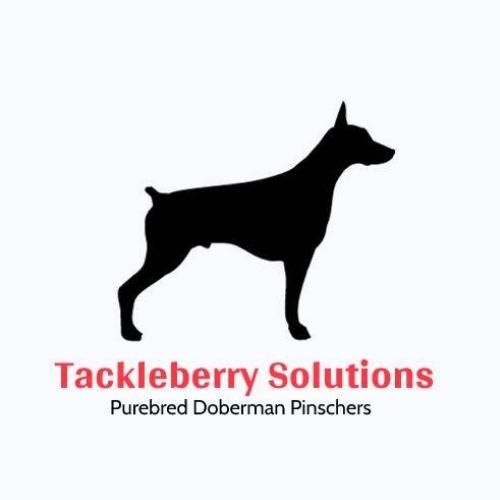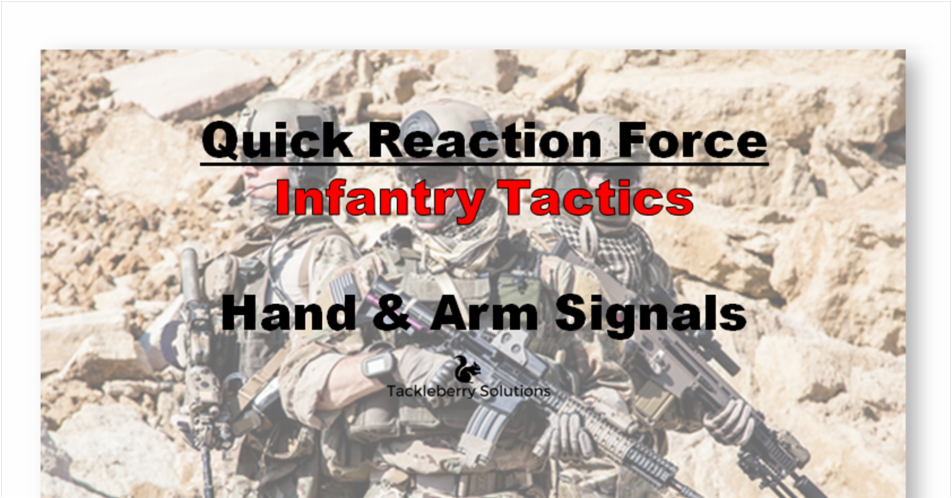How to travel during wartime without getting ambushed - QRF Infantry Tactics
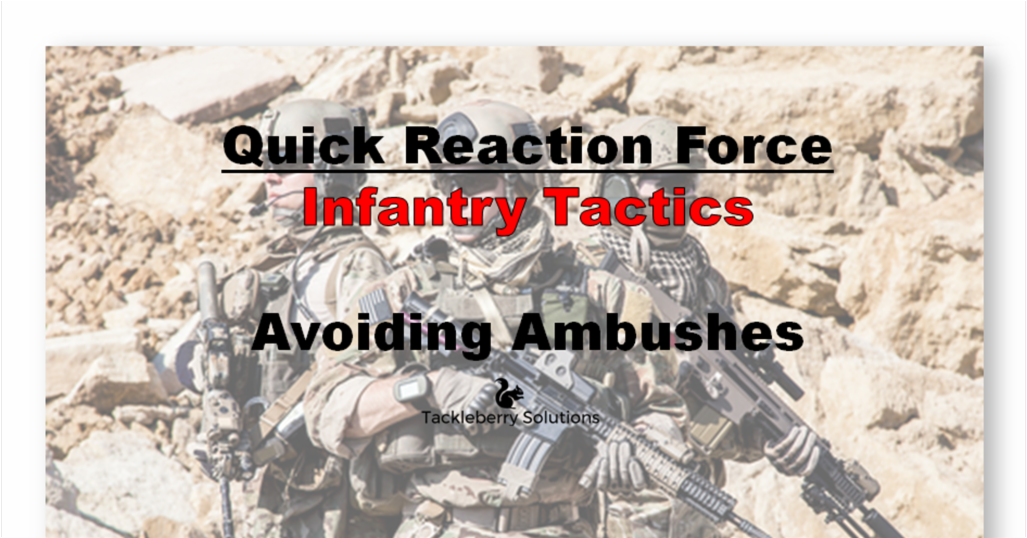
Guerrilla warfare and tactical ambushes can chip away any force until there is nothing left, no matter the size. Be smart when you are going from one location to another during wartime or shtf.
This article is part of a series we are using to teach QRF Infantry Tactics. Here is an outline of the free lessons. They are numbered in the order they are taught in the printed book.
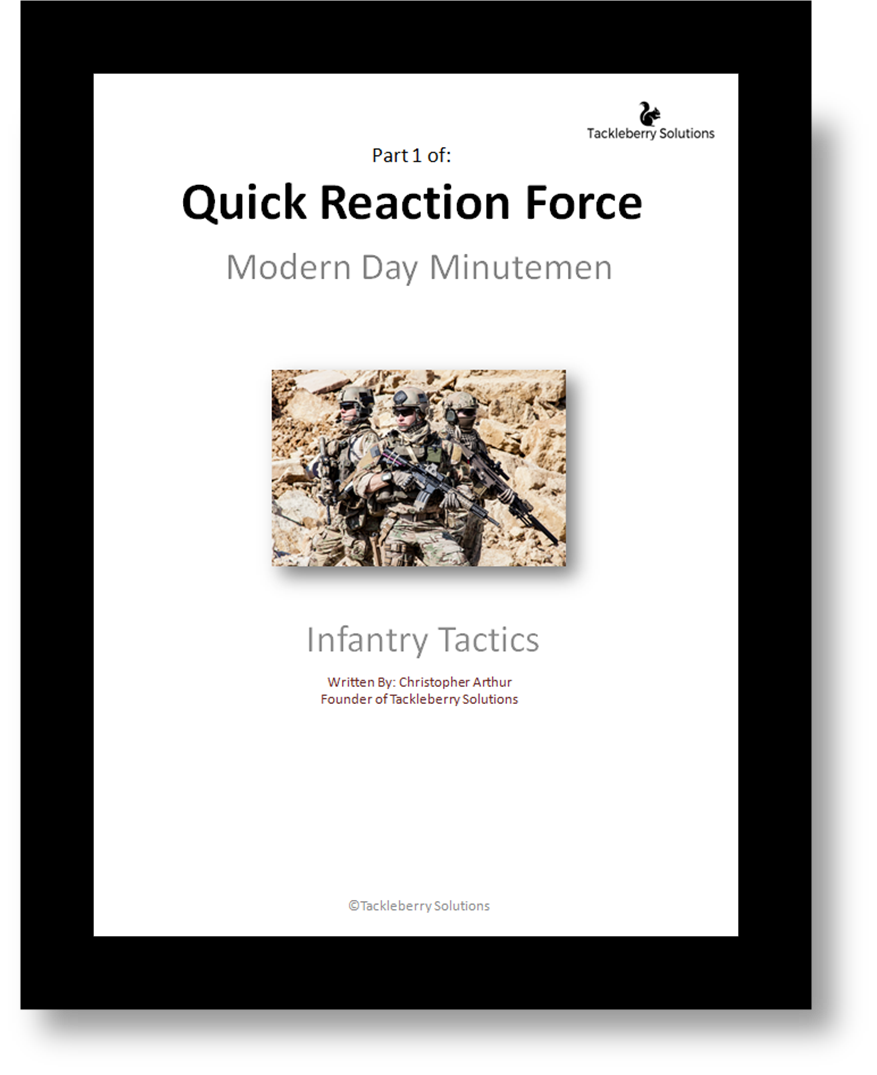
- How to Form Your Own Platoon
- How to Travel During Wartime Without Getting Ambushed
- Hand & Arm Signals - Communicate Silently
- Prisoners of War
- How to Remove the Injured From Battle
- Reaction to Contact (How to Respond if You Get Attacked)
- How to Stop an Armored Vehicle
- Convoys and Obstacles
- How to Identify, Locate and Avoid Landmines
- Fighting Back: How to Ambush Your Enemy
- Fighting Back: Tactical Formations
- Breaking Contact (How to Retreat)
- How to Conduct TCPs (Traffic Control Points)
- A Letter to the Commander (How to Keep Your Men Alive)
- A Story of Battle (What a Real Ambush Looks Like and How I Lived Through It)
Introduction - Avoid an Ambush
*Important Note* This is lesson 2 of our QRF Infantry Tactics series. Click here to read the article on lesson 1.
Below you will see a summery of the article, "How to travel during wartime without getting ambushed." Each section is linked so that you can go straight to the topic you're interested in learning about. Use the "Back to Top" button on the bottom right to navigate back up to the article summery if you want to view a different topic. Or you can simply scroll up or down if you want to take the time to do so.
If you have any questions at all about the tactics or methods mentioned in this article, you can ask by either leaving a comment at the bottom of the article, sending us an email to prepare@tackleberrysolutions.com or you can even call Arthur directly at 919 - 223 - 7741.
Article Summary
Team Movement - Avoid an Ambush
Rally Points- Predesignated location for your men to fall back to. This would be used as a gathering point after a raid, breaking contact, or when one member is separated from the group. It can also be used as checkpoints along the route of travel to ensure you are on course. (i.e. a place where your men meet up)
Rally pints should be approximately every 1,000 yards or so. Depending on the terrain and distance of movement. Be sure everyone knows the grid coordinate for every rally point before stepping off.
Casualty Collection Point- Predesignated location just outside the contact area of a raid sight, or locations along the route of travel, in which you will collect your wounded for treatment and stabilization for movement to a medical facility. It can also double as a rallying point. (i.e. a place to fall back to and deal with the wounded)
Planning Ahead - Avoid an Ambush
When you plan ahead, give yourself time to get the rest of your guys on the same sheet of music as you. This also allows them a chance to give you some feedback. Make sure your guys know what the mission is, how it's going to be conducted, and what is expected out of them. This makes it easier for them to overcome challenges mid-battle.
Use the KISS method and keep it simple. Always leave room for flexibility in the plan. No matter how great your plan is, Murphy’s Law will always throw you a monkey wrench that you will have to improvise, adapt, and overcome.
Routes of Travel/Avoiding Ambushes - Avoid an Ambush
When planning routes of travel, there are 4 key concepts to keep in mind in order to avoid ambushes and trouble:
- Stay off roads or main travel paths.
- Never use the same route to and from.
- Know the target area in relation to allied forces (theirs and yours, i.e. “If I get into trouble, where is my nearest backup?)
- Identify where your closest medical assets, food, water, ammo, etc.
You should always plan the mission from the second you step out of the wire till you get back into your FOB. More than that, have backup plans and backup plans for your back up plans. You need to have at lest 3 different ways you intend to complete your mission.
Use local maps and any areal recon completed recently by drones. Other teams that have recently conducted missions in that area can also be a great source of information. Sig acts or significant action within the last 24 hours will tell you just what kind of crap you might be walking into. Typically your community commander and community commo guy are aware of the last 24-hour sig acts.
Crossing Danger Areas: Definition/Solution - Avoid an Ambush
Danger Area-Any open space in which you cannot bypass and must cross through. A location that provides NO cover or concealment. Example: Moving from woods across the road to woods on the other side. Creeks and small openings in the woods are also danger areas.
How to Cross- If you cannot maneuver around the area, then post guards looking both ways down the road, creek, etc as team members cross one at a time.
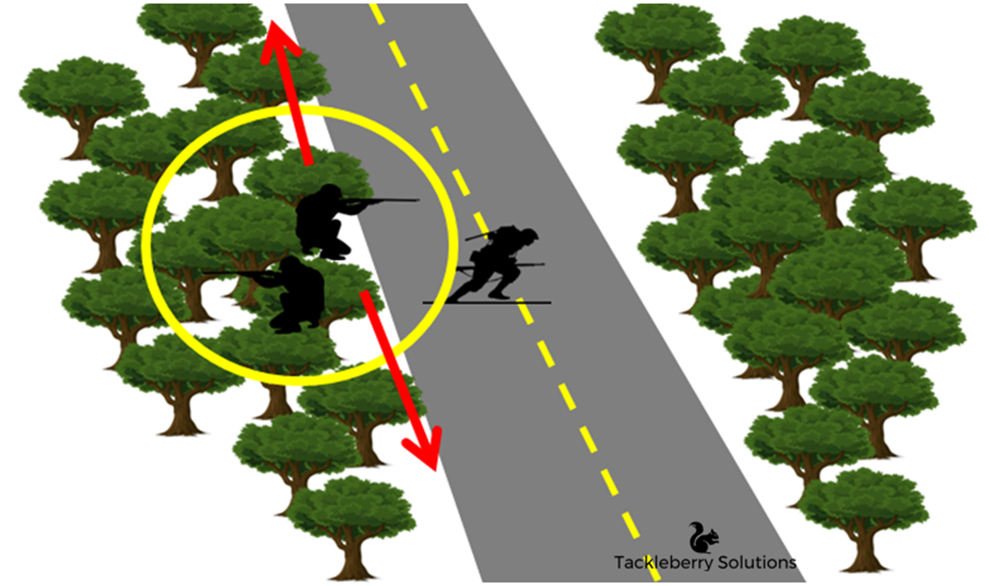
The first two across must pull far side security for others to cross between them. Remember 360 security at all times.
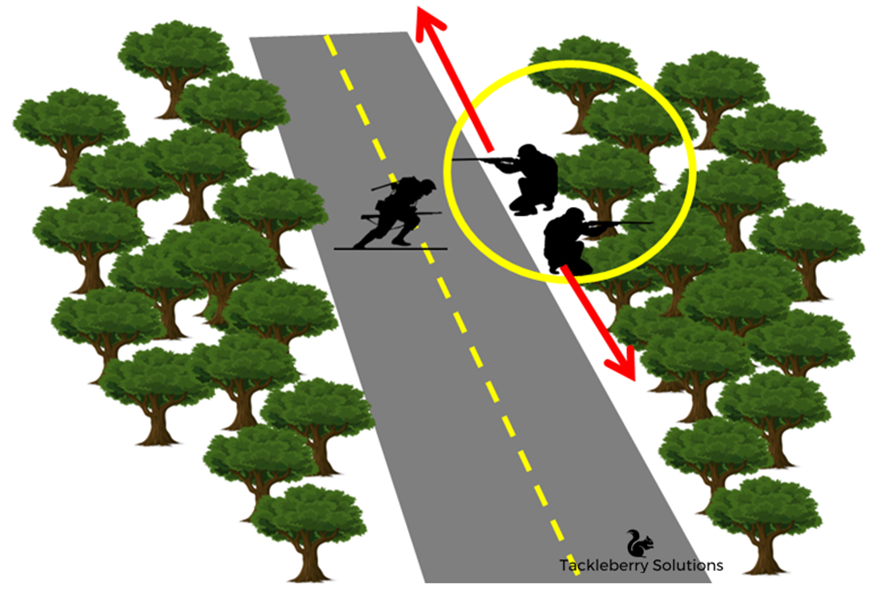
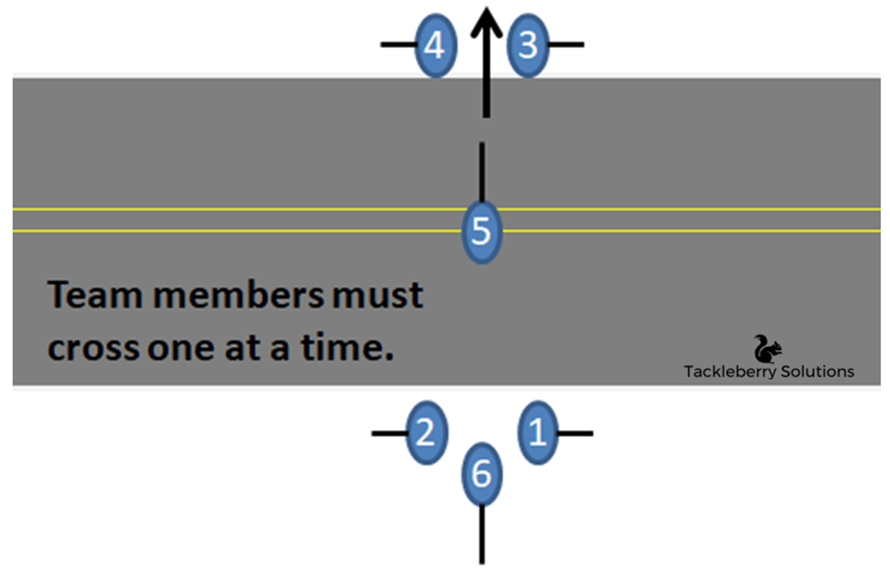
Learning from History - Avoid an Ambush
During the Battle of Trenton, George Washington forced his men to march through the night. They left bloody footprints in the snow (from lack of proper shoes) just so they could be in a position to attack Trenton at dawn.
Unfortunately, the intense snowstorm and freezing temperatures kept Washington from arriving in time. Instead, he got there several hours after dawn. Furthermore, he found that he only had ½ the force he had intended to use(the frozen river stopped half of his army from crossing) and that the element of surprise had been lost.
A small group of men from a local militia had already conducted a hit and run attack. With his force outnumbered, men half frozen, he said, “We have come too far to turn back. If we attack now, we might have the day. If we turn back, we will surely lose the war. Victory or Death!”
Fighting in the Snowstorm
He pushed forward and captured Trenton. (What he didn’t know at the time: The commander of the Hessian army was aware of his attack plans. He thought the attack from the militia group was the big attack from Washington. The Hessian commander felt sorry for his men and didn’t see the need to keep them in the storm any longer. Thus he ordered them to abandon their stationary guard post and seek cover from the storm.)
Some of the first kills during the battle of Trenton were done by Washington’s advanced recon party. They used knives and bayonets to silently kill unsuspecting roaming guards. This allowed Washington’s army to penetrate further into the city before the alarm was raised by gunfire.
The snow was so thick that by the time the Hessian Commander realized they were under attack, Washington was literally riding a horse down the main street.
The point of this story is to use the elements to your advantage. DON'T abandon your guard points, no matter what. I know it sucks, but moving in the rain is a huge advantage. No one can see or hear you, and no one really wants to be out in that crap anyway.
Little random tips from personal experience: - Avoid an Ambush
•Wet leaves make no noise when you walk on them. And it’s harder to track after a rainstorm has passed because the heavy rains wash away all prints. So if you have a choice to attack during the heavy rainstorm or in the clear beautiful weather, take the storm. Thunder also covers up the sound of gunshots.
•Attack in the middle of the night. Like 2-4 am. Most guards are out of it and to busy fighting the sleep monster. You will have no trouble sneaking up and taking them out with your blade.
•Most glass optics (think scope, red dot, etc) have a hard time working in severe weather. For this reason, Simo "Simuna" Häyhä, nicknamed "White Death" by the Red Army, only used iron sights on his “sniper rifle”. He was a Finnish sniper that had over 505 confirmed kills.
•Anything that uses batteries will fail you at some point. Most likely when you need it the most.
•I always use the time method when working. The radios are just used as a convenient backup.
•The time method is: Planning your mission using set times during the day instead of signals or radio calls. Your men will know that they have to have key parts of the mission done and be in a certain place during specific times. This enables you to plan your end of the mission based off of what time it is. Have backup plans for if one team fails to arrive on time, then the other team falls back to plan B.
•Anti- tracking tip: Rolling in the dirt or in animal poop will change your scent. This makes it harder to be tracked or noticed. I personally opt for rolling in the dirt and leaves.
•While making your way through hostile territory and you come up on the enemy - just freeze in place. Don’t drop suddenly to the ground. Fast movement attracts the attention of the human eye. Instead, slowly lower yourself down.
Team Leader Recon - Avoid an Ambush
Platoon Leader Recon- It isn't necessary to expose the entire team in order to gather information. In fact, you will make less noise and be more effective if your main body stays behind you as a QRF. It should only require two or three of you to put an eye on the objective and formulate a plan of action. The personnel on this recon is your LT, a radioman, and usually your senior.
Side Note: This is where those 2 and 3 man formations come in handy, assuming you’re not walking in thick underbrush.
Questions to ask yourself when gathering information:
• How many enemy personnel are there?
• What’s the best flanking position for my Bravo element?
• What should we take out first?
• Where are my snipers going to be?
• Where do I want my baseline of fire?
• Can I only use my snipers for outer perimeter or do I need to use an entire section.?
• Etc.
Feel free to get as close as you can without being spotted. The closer you, are the more information you can get and the better your plan of assault will be.
Below is a diagram with an example of a platoon leader recon. Notice how the main body stays behind while the key leader moves forward to observe the target.
Both parties have a radio so that if they see or hear something, they can communicate without having to yell and expose their location. Furthermore, if the recon team gets into trouble, they can call for backup. If the main body gets into trouble, the recon team can come in and flank the attacking force.
Side Note: Stay within 200 yards of your guys at all times. Radios will fail you at some point.
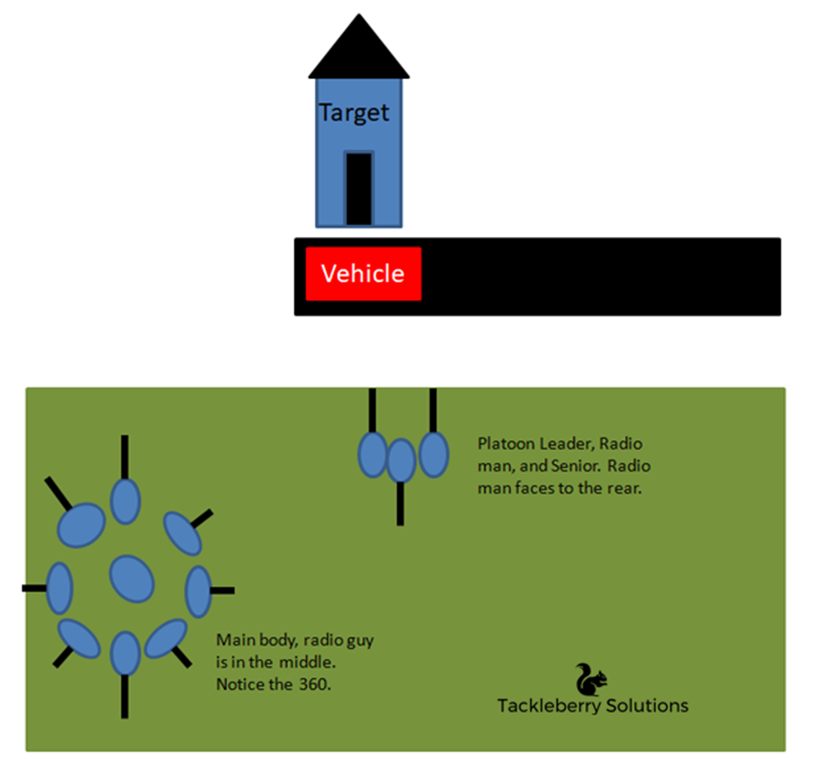
- The 3 soldiers at the top are the Platoon Leader, Radio man, and Senior. Radio man faces to the rear.
- The circle of men at the bottom is the main body with the radio guy in the middle. Notice the 360.
Ambush Points - Avoid an Ambush
Pay special attention to terrain and objects that create idea ambush locations. The following examples will give you an idea on what to look out for.
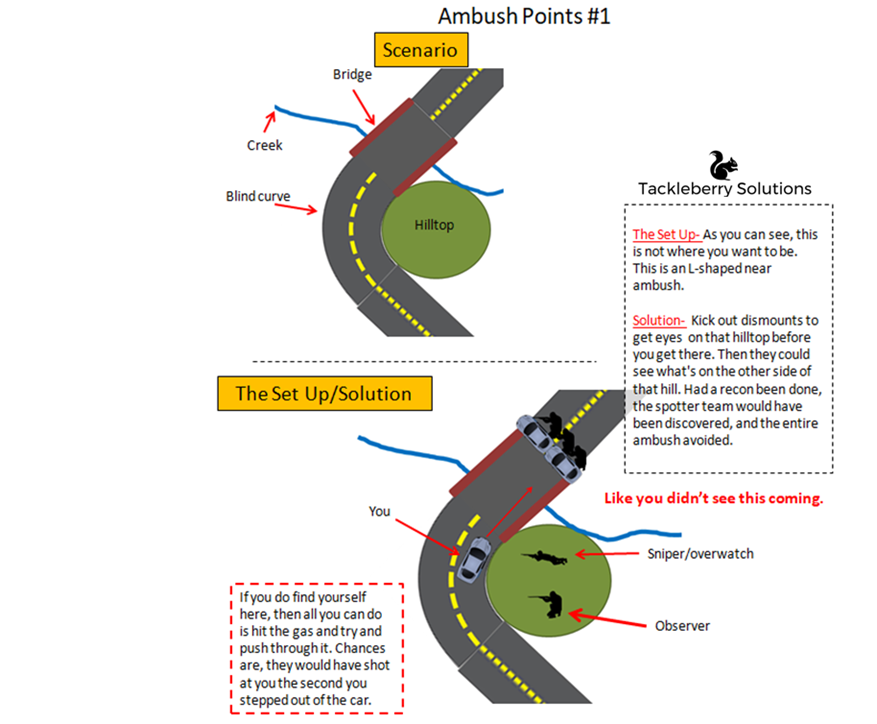
- The Set Up- As you can see, this is not where you want to be. This is an L-shaped near ambush.
- Solution- Kick out dismounts to get eyes on that hilltop before you get there. Then they could see what's on the other side of that hill. Had a recon been done, the spotter team would have been discovered, and the entire ambush avoided.
If you do find yourself here, then all you can do is hit the gas and try and push through it. Chances are, they would have shot at you the second you stepped out of the car.
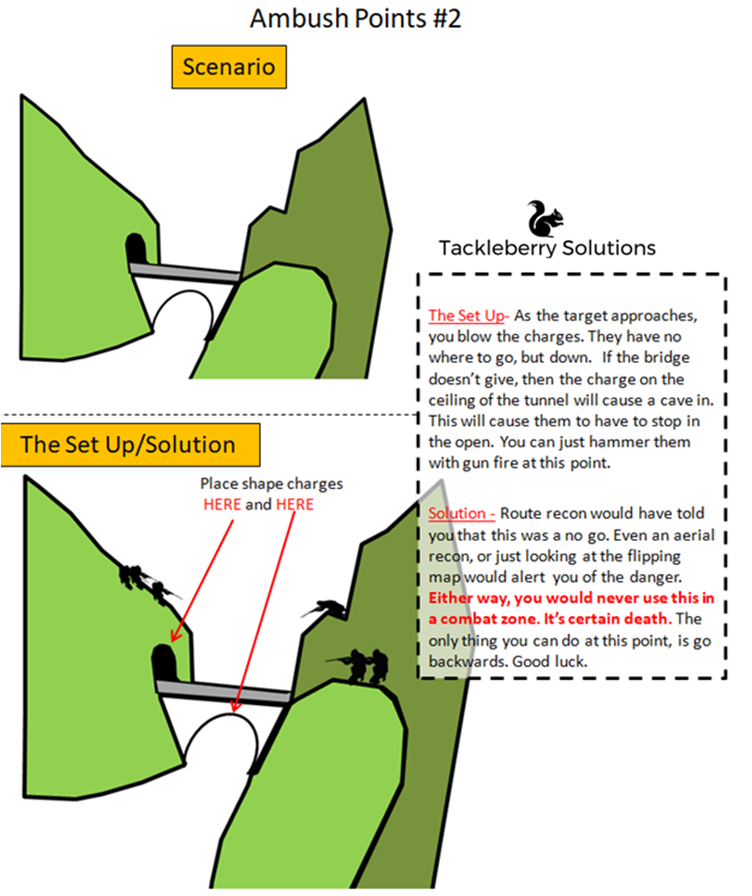
- The Set Up- As the target approaches, you blow the charges. They have no where to go, but down. If the bridge doesn’t give, then the charge on the ceiling of the tunnel will cause a cave in. This will cause them to have to stop in the open. You can just hammer them with gun fire at this point.
- Solution - Route recon would have told you that this was a no go. Even an aerial recon, or just looking at the flipping map would alert you of the danger. Either way, you would never use this in a combat zone. It’s certain death. The only thing you can do at this point, is go backwards. Good luck.
Hand and Arm Signals - Communicate Silently
Now that you've learned about team movement, avoiding ambushes and planning ahead - it is time to learn about Hand and Arm Signals so that you can talk in silence. Click here to read the next article.
Definitions/Terms
2-3 Second Rushing- “I’m up, he sees me, I’m down.” That what you say to your self as you run from one cover/concealment location to another. This is done so you can advance or retreat without getting shot. By the time the enemy gets his sights on you, you’re hitting the ground. Then your buddy jumps up and runs.
360 Security- Always maintain the ability to fire and scan in every direction. The fewer men you have, the more vigilant they must be in monitoring their sector of fire.
AUW – Advanced Urban Warfare are advanced tactics for fighting within an urban environment.
Baseline of Fire- a position usually formed by the Alpha team. All members come and form a line facing the enemy. Remember to keep 360 security. Then they use suppressive fire to keep the enemy heads down and attention on.
Bound and overwatch- One soldier shoots with suppressive fire while the other advances onto the enemy’s position, or retreats from their position. Often using 2-3 second rushing.
Breaking contact- basically you realize that you have bit off more than you can chew and wanta get the hell out of there alive. There are formations and tactics to do this properly. Bound and overwatch, Auzzy Peel, and Rolling Peel.
Casualty Collection Point- Predesignated location just outside the contact area of a raid sight, or locations along the route of travel, in which you will collect your wounded for treatment and stabilization for movement to a medical facility. Can also double as rally point.
CCT- Casualty Collection Team. A small team that usually consist of 3-4 guys that collect the dead or wounded during the fight. This is seen more often in AUW (Advanced Urban Warfare).
Choke Point – This is much like a fatal funnel, it is an area that you have no choice but to go through due to the natural terrain features. Example: a bridge over a large river.
Commo - communications
Concealment- A position behind an object that cannot stop bullets or fragmentation, but can act as a visual block. (i.e. tall grass)
Convoy - A group of vehicles traveling in the same direction for the same purpose.
Cover- A position behind an object that can stop bullets, fragmentation, and visual contact. (i.e. Rock)
cross-load ammo – This is like socialism, but with ammo. You will compile all of your ammunition and distribute it equally. This is typically done after a firefight.
Direct Fire- Precision incoming fire. Think J-Dam off a F-15 or rifle fire.
Dismounts – Men that get out of the vehicle and push forward on foot to either engage the enemy or clear an obstacle.
EPT- Enemy Prisoner Team. Similar to the CCT, but not as caring. They secure and search the POW again and move them (wounded or not) to the POW security point for yet another search, treatment, and evacuation for further interrogation. CCT can double as EPT.
Far Ambush- an attack that is outside of hand grenade range.
Fatal Funnel – This is like a choke point. It is an area that gives you no choice but to go through in which you have no option to go left or right. The only way out would be to push forward or go backwards.
Flanking- Moving toward the blind side of the enemy to gain tactical advantage.
FLIR Imagery – This is an advanced thermal optic used by drones and other aircrafts to spot personnel, weapon cashes or anything else that gives off a heat signature. This is very difficult to avoid.
Force on Force Training - Split your platoon in half and have one side defend, while the other side attacks. Be sure to use actual projectiles such as air soft, paint ball, or SIM rounds.
Formation- A specific placement of men to gain maximum tactical advantage.
Forward Operation Base (FOB) – Is a city within a city. Much like a standard military base here in America. Just this base is totally geared for war. Round the clock guards, stationary and roaming, TCP, etc.
Grenadier - Is the guy that carries the grenade launcher and grenades. Second most important weapon system in a fight. Can cause mass casualties with only one shot.
Indirect Fire- incoming fire that is from an arial weapon. Think artillery, mortars, or grenade launcher.
Intervals – distance between each person
KIA- killed in action.
KISS – Keep it simple stupid
Lift and Shift- A command given by team leader to fire high and away from your approaching troops. This keeps enemy’s heads down without hitting friendly forces.
Limit Of Advance – When advancing through an objective, this is an area where you stop your assault.
L-Shape- L shape ambush is when you literally place your men in a form of an L and let the enemy walk into your cross fire. With this shape, there is no way you can hit each other. But your enemy has nowhere to go and is getting hit from what seems like all sides.
LT – Lieutenant, the lowest rank that a commissioned officer can hold in the military. In my experience they are usually “GOOD IDEA” fairies and cost you more sleepless night and pain than any one else.
LOA- Limit of Advance. Tells the men in your section to stop movement, and commander of other section to start their assault.
LZ – Landing Zone for an aircraft.
Murphy’s Law – An old army wise tale. Anything that can go wrong will go wrong, it’s Murphy’s law.
NCO – Non-commissioned officer, where the rubber meets the road, the backbone of the military. The guy that puts foot to ass, trains the men, keeps them alive in a hot zone, and makes heroes out of LT’s.
Near Ambush- An attack that is within hand grenade range. I.E. I can throw a hand grenade and it kill the enemy.
Neighborhood Guardian – Is like the stationary or roaming guard. The watchdog of your community.
Package - A term used for the person/thing that is being protected or delivered.
Pat Tillman – Former NFL player that joined the Army Rangers after 9/11. Was killed in action during a firefight in Afghanistan. Stood up from behind cover in front of his team and was hit by friendly fire.
Platoon – Is a group of men that comprise of two sections of about 6 soldiers. They are headed by the platoon Sergeant and Lieutenant.
Platoon Leader Recon- when the LT, Senior, and a radio guy move forward to observe the objective while leaving the main body behind . This is done to prevent too much noise from excessive movement.
Point Man – The man that is at the front of your formation, this is typically a sniper.
POW- prisoner of war.
Prone - The most stable firing position and the safest during a firefight. Just lay down.
precision fire – Shooting carefully to aim and actually hit the target instead of just spraying lead.
QRF (Quick Reaction Force) – Modern day minutemen. You can also think of them as emergency responders during war.
Rally Points - Predesignated location for your men to fall back to. This would be used as a gathering point after a raid, breaking contact, or that one member that gets separated from the group. Can also be used as check points along the route of travel to ensure you are on course.
Ranger File – Think ducks in a row. Walking in a single file line. This is used in areas with thick under brush.
Reaction to contact – Reacting to enemy shooting at you. Depending on the situation, you will react a certain way.
RPK – Russian version of a squad automatic weapon, typically carried by their machine gunners.
Sector of Fire- The area in which you are responsible for and have free range of engagement.
Sig acts – Significant activities within the last 24 hours. Firefights, enemy activity, etc.
SLLS - Pronounced Seals, stands for Stop, Look, Listen, Smell. Basically just be observant, you might just find something.
Sniper- an enemy sharp shooter that uses concealment to hide their position while delivering procession fire on enemy.
Stationary Guards – Guards that sit in one location observing their sector of fire.
Stockholm's Syndrome- A state of mind prisoners can develop in which they sympathize with their kidnapper and no longer try to escape.
Suppressive Fire- one round a sec. This is designed to keep the enemy’s head down while your other section advances onto their position.
S vest - Suicide vest. A vest that is rigged with explosives, designed to be worn by individuals willing to blow themselves and others up .
TC - Truck or Track Commander
Thermal Sighting Imagery – Optic system used to see day or night based upon your body’s heat. Does not work through glass or any kind of obstruction. Also faulty in the desert at high noon as everything is hot.
Triage – This is where you assess the wounded in mass amounts so that you know who to treat first that have a better chance of living.
Train to Failure – Train as if everything is failing you. Radios die, weapons jam, no support, medic is dead, etc.
Victim Detonated – Basically a booby trap that is detonated by the victim themselves be it via trip wire, thermal imagery, pressure plate, etc.
VIP - Very Important Person
Wedge Formation - Formation used when in the open. Designed to look like a wedge. Gives you more of a chance of surviving a sniper ambush.
Side note: When you get into contact with the enemy just yell out your commands. The enemy knows you’re there anyways. Be sure that the command is repeated back to you by the rest of the group. This is to ensure they understood the order and to give anyone that didn’t hear it a second chance at hearing the order. Furthermore, dig deep, grab your balls and sound off. Use your man voice. When all hell is breaking out around you and guys are dying, no one is going to hear or listen to you if you sound like freaking Mickey Mouse.
